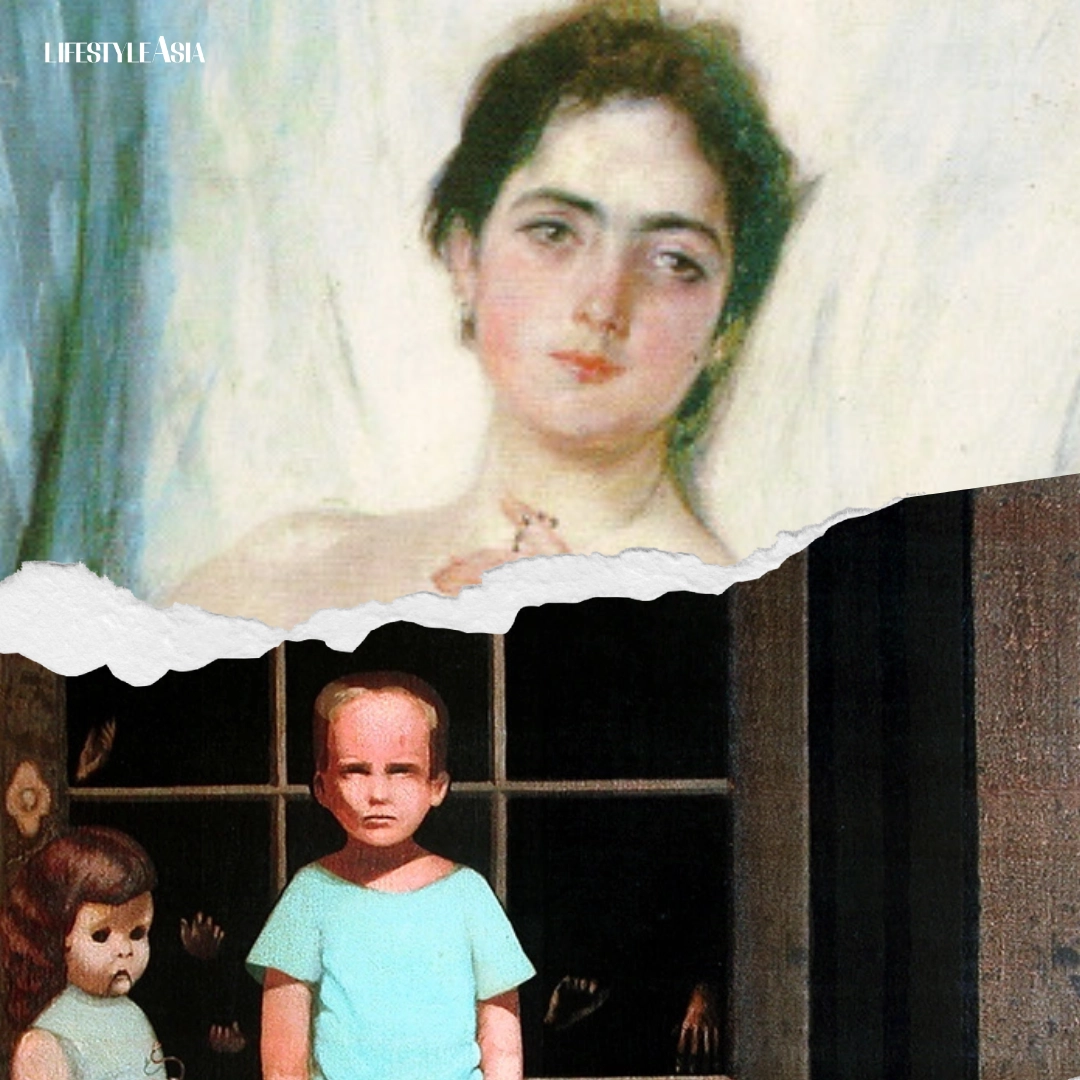From studying art on his own in Nueva Ecija to having his masterpiece join the next NASA time capsule, Semper shares his creative path.
Strolling along the streets of the neighborhood market in his Cabanatuan hometown, Gromyko Semper would take in the scenes in his head. He would sketch images of vendors and roosters on paper, drawing from memory. “As a child, my imagination is quite curious to record things I’m interested [in],” the artist says.
When he is at home, he would fill his notebooks with illustrations of his favorite comic books, manga, and anime like Dragon Ball Z. “That’s what fueled me to start drawing at such an early age.”
ALSO READ: Moon Museum: The Works Of Filipino Artists And Writers Will Be On NASA’s Next Lunar Landing

Ink, acrylic, oil, and distemper on canvas
6x4ft
2017
RIGHT: “The Garden at the Edge of the Road”
Mixed media on canvas, 2017.
Encounter with new worlds
Hailing from Nueva Ecija, Semper enrolled in a class at a local art gallery. “Although it’s not a formal art school, they teach basic art techniques like how to use oil paints, acrylic paints, or charcoal drawings,” he reveals. “But upon realizing that my skill level is not enough, I tried to do my own research.”
It was the late 90s and internet usage was not as widely and fully adopted in the country, and data and download speeds were not the same as it is now. (Although current internet speeds aren’t something to write home about either.) “I had to rely on the good old references for me to further my knowledge on painting, drawing, [and] all the basic stuff of art,” Semper shares.
As he spent time studying art history and artistic media in nearby libraries, Semper was also exposed to the works of great poets, philosophers, psychologists, and writers: Dante Alighieri, William Blake, Edgar Allan Poe, Sigmund Freud, and even Jewish manuscripts on mystical arts, mythologies, and Surrealism.
“I relate much to their exploration of dreams, visions, and the power of imagination to express the subconscious,” the artist elaborates. “By combining the subconscious and the conscious, we can delve deeper into the understanding of the human condition.” Through art, Semper answers questions about the meaning of life as with Paul Gauguin’s painting, “Where Do We Come From? What Are We? Where Are We Going?”

Mixed Media on canvas, 2015.
Drawing on influence
The self-taught artist’s works combine his literary classics and visual artists inspirations. He started from black and white similar to lithographs then shifted to color inspired by Albrecht Dürer’s paintings. Now, the 36-year-old’s masterpieces feature woodcuts influences, engravings, fine linear details, lithography, and Ukiyo-e like the famous “The Great Wave.”
In every piece creates, Semper tells a story filled with symbols and literary references. “I’m not particularly tied up to some particular style because I often shift with the subject matter of the thematic meaning of the works. I try as much as possible to make the work filled with narrative details,” he explains.
Interestingly, he doesn’t believe in ‘artist’s block.’ “As an artist, you should have a very curious and open mind [to those things you experience or see],” Semper says. “It could be the [silliest] things, the [banalest] things [that will trigger you to create].” There is also no need for him to work in a particular environment or set up to be inspired. His only companion is to have a mosquito net around him in his studio.

Ink and acrylic on canvas, 2016.
RIGHT: Self-portrait
Ink on paper, 2017.
Masterpiece on the moon
Semper is among the 1,500 artists and writers whose works will be sent on a time capsule to the Moon. The ongoing project, The Lunar Codex, is led by Dr. Samuel Peralta in partnership with the U.S. National Aeronautics and Space Administration (NASA).
“A friend of mine, [the] American artist Steven DaLuz called me,” Semper explains on how he got invited to the prestigious NASA project. DaLuz’s “100 Great Drawings” for PoetsArtists Magazine features Semper’s “Tristan and Isolde” which was selected to be part of The Lunar Codex.
The work depicts the Celtic legend about the fated lovers and bears Semper’s mark of detailed forms and elements. “You can see the final moments before they took the potion that ended their lives,” the artist describes. “[I’m conveying] a universal emotion, the feeling of love between two people [who are forced to separate].”
Coincidentally, the artist is fond of including the moon in his works, and used it again in his piece for the Lunar Codex. “It is their final moment, the final light of the moon that they are going to see,” he adds. “[There’s this] element of tragedy in this artwork. It sums up a human condition that there’s love, fear, sacrifice, romance, life, and death.”
ALSO READ: Virtual Tokens: What Are NFTs And How Do They Go Beyond Acquiring Art?

Mixed media on canvas, 2017.
Creating with meaning
Like many artists in the pandemic, the digital landscape is his platform to exhibit his works. Apart from online shows, he works on large-scale drawings to be exhibited in the Altro Mondo gallery next year.
“I’m [also] currently exploring the possibilities of non-fungible tokens,” he continues. NFTs are similar to certificates of ownership for digital or physical assets. From video clips, digital art, to traditional paintings, anyone can ‘own’ the ‘original’ works via cryptocurrency.
While balancing his time between family and making art amid the pandemic, Semper never forgets to reflect on the legacy he will leave. Despite these difficult times, he aspires to “contribute to the betterment of others… to give back to the community, to give back what I’ve learned from my field of study.”
Be it in honing his talent, caring for his family, and helping others, Semper believes these wouldn’t be possible without God. “[You have to] acknowledge God who gave you the talent, your strength, your vision, your imagination, [and] everything that you have right now. A life without him with the meaningless.”
Photos courtesy of Gromyko Semper.





